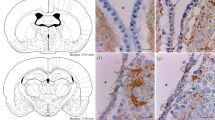Summary
The primary plexus of the toad hypothalamic-adenohypophysial portal system has two types of loops. The short loops are localized in the external region of the median eminence and surrounded by nerve endings and glial cells. The long loops approach the ependymal lining of the median eminence. The ascending and descending branches of these loops are surrounded by nerve and ependymal endings and glial cells. The actual subependymal portion of the long loops is virtually in contact with ependymal processes only, which form a “cuff” interposed between this portion of the long loops and the fibres of the hypothalamic-neurohypophysial tract. Many of the vascular endings of the ependymal processes have electron dense granules whose diameter ranges between 700 and 1400 Å. The ultrastructure of the ependymal cells suggests that these granules are transport material and not secretory material.
This anatomical arrangement linking the ependyma of the median eminence and the long loops of the primary plexus of the hypothalamic-adenohypophysial portal system makes the possibility of an interrelationship between the cerebrospinal fluid and the portal blood very considerable.
Similar content being viewed by others
References
Adams, J. H., P. M. Daniels, and M. L. Priehard: The effect of stalk section on the volume of the pituitary gland of the sheep. Acta endocr. (Kbh.) 43, Suppl. 81, 3–27 (1963).
Cummings, J. F., and R. E. Habel: The blood supply of the bovine hypophysis. Amer. J. Anat. 116, 91–113 (1965).
Duvernoy, H., et J. G. Koritké: Sur le trajet juxtaventriculaire des vaisseaux de la neurohypophyse. C. R. Acad. Sci. (Paris) 258, 6533–6536 (1964).
—: Les vaisseaux sous-épendymaires du recessus hypophysaire. J. Hirnforsch. 10, 277–245 (1968).
Enemar, A.: The structure and development of the hypophysial portal system in the laboratory mouse, with particular regard to the primary plexus. Ark. Zool. 13, 203–252 (1961).
Engelhardt, T.: Über die Angioarchitektonik der hypophysär-hypothalamischen Systeme. Acta neuroveg. (Wien) 13, 129–170 (1956).
Fumagalli, Z.: La vascolarizzazione dell'ipofisi umana. Z. Anat. Entwickl.-Gesch. 3, 266–306 (1942).
Green, J. D.: The histology of the hypophysial stalk and median eminence in man with special reference to blood vessels, nerve fibres and a peculiar neurovascular zone in this region. Anat. Rec. 100, 273–288 (1948).
Holmes, R. L.: The vascular pattern of the median eminence of the hypophysis in the macaque. Folia primat. 7, 216–230 (1967).
Ishihara, K., and Y. Nagamachi: ACTH release on intraventricular and intrahyophysial administration of pitressin and adrenalin. Gunma Symp. Endocrinol. 1, 159–165 (1964).
Kumar, T. C. A., and F. Knowles: A system linking the third ventricle with the pars tuberalis of the Rhesus monkey. Nature (Lond.) 215, 54–55 (1967).
Lenys, D.: Etude morphologique des relations neuro-vasculaires hypothalamo-hypophysaires. Thèse de Médecine, Nancy, France (1962).
Leonhardt, H.: Bukettförmige Strukturen im Ependym der Regio hypothalamica des III. Ventrikels beim Kaninchen. Zur Neurosekretions- und Rezeptorenfrage. Z. Zellforsch. 88, 297–317 (1968).
—, u. E. Lindner: Marklose Nervenfasern im III. und IV. Ventrikel des Kaninchen- und Katzengehirns. Z. Zellforsch. 78, 1–18 (1967).
Leveque, T. F., F. Stutinsky, A. Porte et M. E. Stoeckel: Morphologie fine d'une différentiation glandulaire du recessus infundibulaire chez le rat. Z. Zellforsch. 69, 381–394 (1966).
Löfgren, F.: The glial-vascular apparatus in the floor of the infundibular cavity. Lunds Univ. Årsskr. N. F. 57, 1–18 (1961).
McConnell, E. M.: The arterial blood supply of the human hypophysis cerebri. Anat. Rec. 115, 175–203 (1953).
Moll, J.: The effect of the hypophysectomy on the pituitary vascular system of the rat. J. Morph. 102, 1–21 (1958).
Nowakowski, H.: Infundibulum und Tuber cinereum der Katze. Dtsch. Z. Nervenheilk. 165, 261–339 (1951).
Oordt, P. G. W. J. van, W. J. van Dongen, and B. Lofts: Seasonal changes in endocrine organs of the male common frog, Rana temporaria. I. The pars distalis of the adenohypophysis. Z. Zellforsch. 88, 549–559 (1968).
Piezzi, R. S., and M. H. Burgos: The toad adrenal gland. I. Cortical cells during summer and winter. Gen. comp. Endocr. 10, 344–354 (1968).
Rodríguez, E. M.: Differences between median eminence and neural lobe in amphibians. Z. Zellforsch. 74, 308–316 (1966).
—: Ultrastructure of the neurohaemal region of the toad median eminence. Z. Zellforsch. 93, 182–212 (1969a).
—: Fixation of the central nervous system by perfusion of the cerebral ventricles with a threefold aldehyde mixture. Brain Res. 15, 396–412 (1969b).
—, and R. S. Piezzi: Vascularization of the hypophysial region of the normal and adenohypophysectomized toad. Z. Zellforsch. 83, 207–218 (1967).
Smoller, C. G.: Neurosecretory processes extending into third ventricle: secretory or sensory? Science 147, 882–884 (1965).
Stanfield, J. P.: The blood supply of the human pituitary gland. J. Anat. (Lond.) 94, 257–273 (1960).
Vigh, B., B. Aros, T. Wenger, S. Koritsansky, and G. Cegledi: Ependymosecretion (Ependymal neurosecretion). IV. The Gomori-positive secretion of the hypothalamic ependyma of various vertebrates and its relation to the anterior lobe of pituitary. Acta biol. Acad. Sci. 13, 407–419 (1963).
Wislocki, G. B., and L. S. King: The permeability of the hypophysis and hypothalamus to vital dyes, with a study of the hypophyseal vascular supply. Amer. J. Anat. 58, 421–472 (1936).
Wittkowski, W.: Zur Ultrastruktur der ependymalen Tanyzyten und Pituizyten sowie ihre synaptische Verknüpfung in der Neurohypophyse des Meerschweinchens. Acta anat. (Basel) 67, 338–360 (1967).
—: Elektronenmikroskopische Studien zur intraventrikulären Neurosekretion in den Recessus infundibularis der Maus. Z. Zellforsch. 92, 207–216 (1968).
—: Ependymokrinie und Rezeptoren in der Wand des Recessus infundibularis der Maus und ihre Beziehung zum kleinzelligen Hypothalamus. Z. Zellforsch. 93, 530–546 (1969).
Author information
Authors and Affiliations
Additional information
Fellow of the Consejo Nacional de Investigaciones Científicas y Técnicas de la República Argentina. The author takes great pleasure in thanking Prof. H. Heller for his constant interest and criticism.
Rights and permissions
About this article
Cite this article
Rodríguez, E.M. Ependymal specializations. Z. Zellforsch. 102, 153–171 (1969). https://doi.org/10.1007/BF00335497
Received:
Issue Date:
DOI: https://doi.org/10.1007/BF00335497




